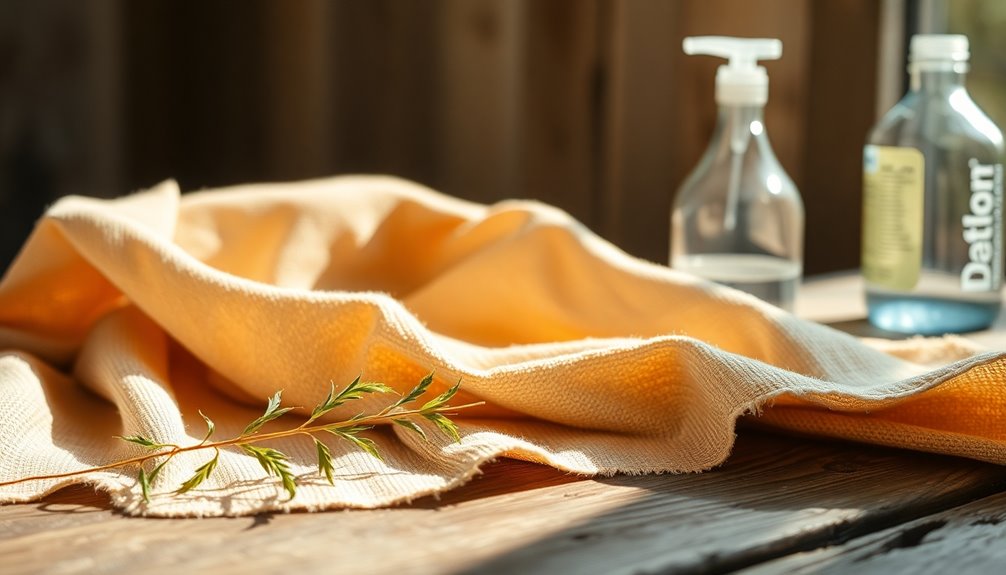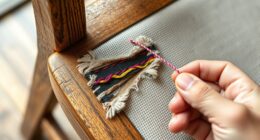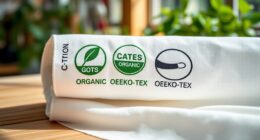Caring for hemp fabric extends the life of your sustainable wardrobe and supports eco-friendly practices. Wash hemp items in cold or lukewarm water with a gentle cycle, and avoid bleach or fabric softeners. For drying, air drying is best; if you use a dryer, opt for low heat. Iron while damp on the reverse side. Act quickly on stains, using mild solutions. Store your hemp fabrics in a well-ventilated area, away from direct sunlight. Following these simple tips ensures your sustainable fashion stays vibrant and long-lasting. Keep going to uncover more about hemp's benefits and care techniques!
Key Takeaways
- Wash hemp textiles in cold to warm water using a gentle cycle and mild detergents to maintain their integrity.
- Air dry garments in a well-ventilated area, avoiding direct sunlight to prevent fading and damage.
- Treat stains promptly with a vinegar solution, rinsing with cold water to preserve the fabric.
- Iron hemp while slightly damp on low to medium heat, always on the reverse side to protect the fibers.
- Opt for recycling and repurposing at the end of life, as hemp textiles are biodegradable and compostable.
Washing Hemp Textiles
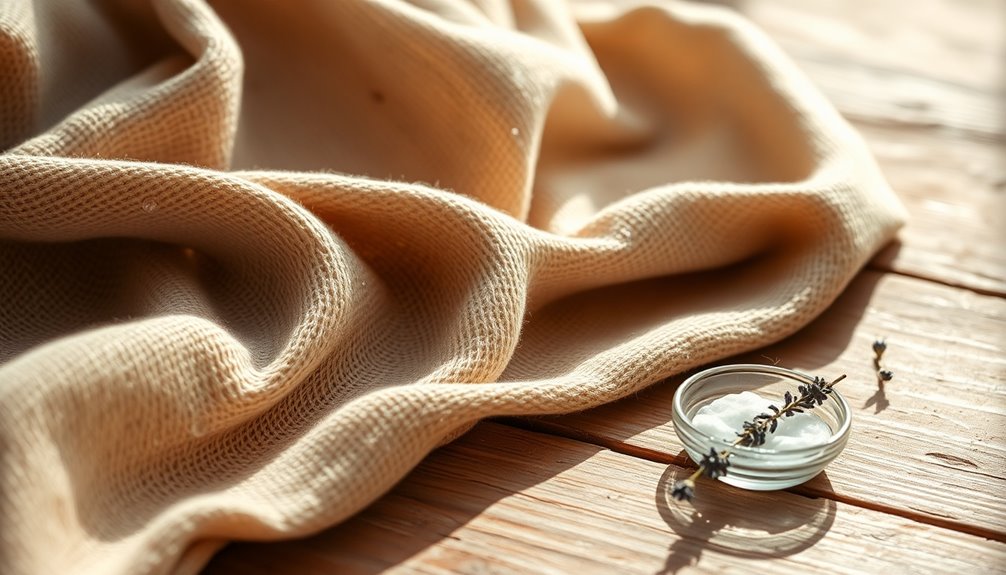
When it comes to washing hemp textiles, you'll want to keep a few essential tips in mind to maintain their quality.
First, always wash hemp in cold to warm water, steering clear of hot temperatures that can wear out the fabric. Use a gentle wash cycle or opt for hand washing to prevent damage. Aim for a half-full machine load to keep your textiles in better condition.
Choose mild detergents free from harsh chemicals, and never use bleach, especially chlorinated bleach, as it can cause yellowing. Natural soaps like gall soap or Marseille soap work well. Avoid fabric softeners, too, since they weaken hemp's absorbent qualities. Instead, consider adding vinegar during the rinse cycle to help remove soap residue and soften the fabric. Additionally, you'll find that hemp is antibacterial, which means you may not need to wash it as frequently as other fabrics.
Tackle stains promptly, treating them before they set. Apply laundry soap directly to the stain, but resist the urge to scrub, as this can damage the fibers. If you need to bleach, stick to oxygen bleaches like hydrogen peroxide.
Lastly, wash hemp textiles separately to protect them from loose fibers, and remember to clean the lint filter after each wash.
Drying Techniques
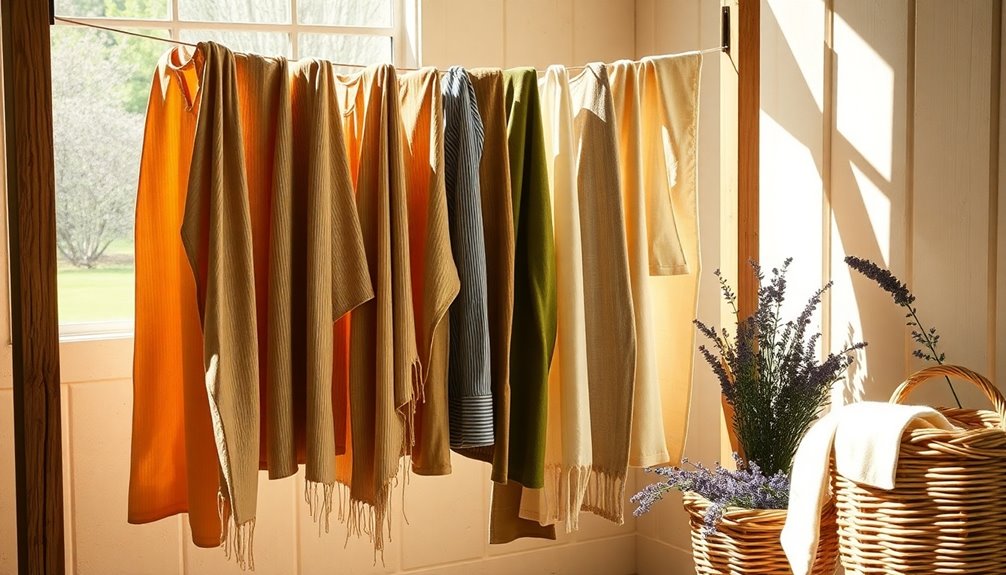
After washing your hemp textiles, choosing the right drying technique is vital for maintaining their quality. Air drying is often the best option. Hang your hemp clothing in a well-ventilated space, but steer clear of direct sunlight to prevent fading. It's important to remember that hemp fabric can shrink with heat, so always consider the temperature settings when drying.
Arrange the garment on a hanger, smoothing out the collar, pockets, and hems as needed. Keep in mind that line drying can stretch lighter weight garments, so take care with how you hang them.
If you must use a dryer, opt for a low heat setting to minimize shrinkage. Remove the garment before it's completely dry to reduce wrinkles, and consider adding dryer balls or tennis balls to speed up the drying process.
Tumble-drying heavier weight items is beneficial for maintaining their shape, but avoid high heat as it can damage the fabric.
To prevent wrinkles, promptly take your garment out of the washer or dryer. If you notice any creases, toss in a damp towel for a few minutes, which can help relax wrinkles.
Ironing Guidelines
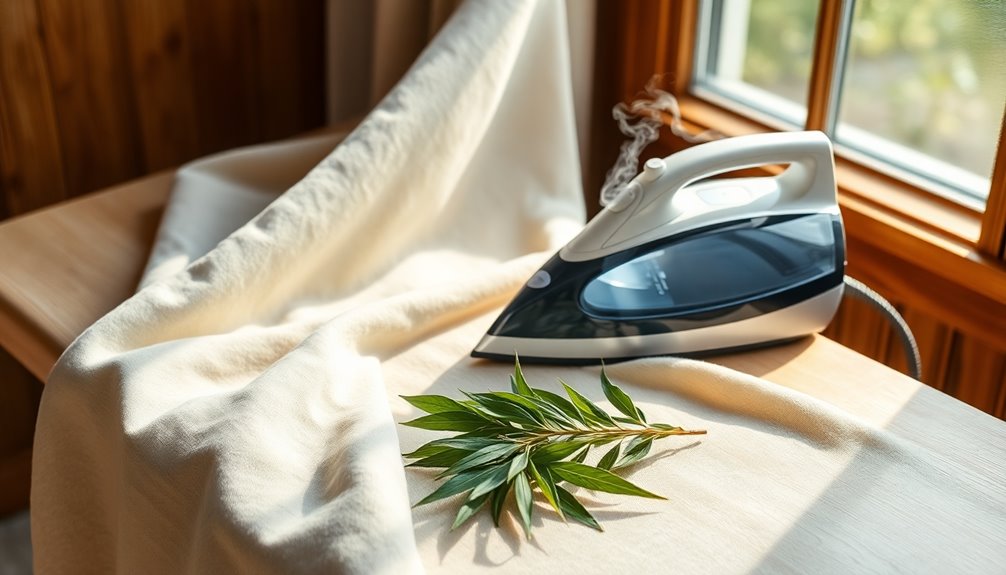
Ironing hemp fabric requires careful attention to temperature and technique to maintain its quality. Start by setting your iron to a low to medium heat, similar to what you'd use for linen. Although hemp can handle higher temperatures, using high heat can damage the fabric. For best results, iron your hemp while it's slightly damp; this makes the process easier and more effective.
Always iron on the wrong side first, especially with light-colored hemp, to enhance its sheen. For darker fabrics, stick to the wrong side only. If you're working with embroidered hemp, place it on a soft towel to preserve the stitch dimensions. A press cloth is essential for protecting delicate areas like lace and cutwork from direct iron contact and preventing marks. Ironing is optional if dried flat or tumbled at low heat, allowing you to maintain the integrity of the fabric without additional stress.
If your hemp items are heavy, you might need a slightly higher temperature. For large pieces like tablecloths, roll them over a table to limit creasing.
Effective Stain Removal
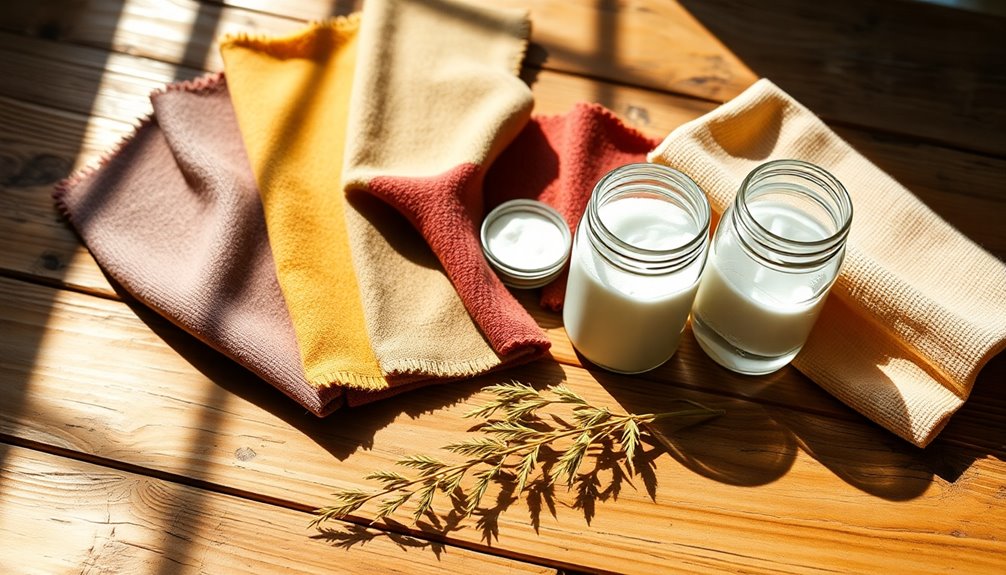
Stains on hemp fabric can be particularly stubborn, but with the right approach, you can effectively tackle them. First, act quickly! Treat stains before they dry to prevent them from setting, as stains left for more than 24 hours can be much harder to remove. Rub a dab of mild laundry soap into the stain, then rinse with warm water. For tougher stains, apply a mixture of equal parts water and white vinegar directly, letting it sit for 10-15 minutes before rinsing. When dealing with oil-based stains, sprinkle talc or flour on the affected area and let it absorb for about an hour. Then, use the vinegar solution to treat the stain, or try hydrogen peroxide mixed with water in a 1:1 ratio. Always use cold water for rinsing to avoid damaging the fabric. Remember, avoid harsh chemicals like bleach and fabric softeners, which can harm hemp. Additionally, proper care for hemp fabric is crucial to maintaining its quality and longevity. After treating the stain, air dry the garment to prevent any further damage from heat. By following these tips, you'll keep your hemp fabric looking fresh and clean for longer.
Maintenance for Longevity
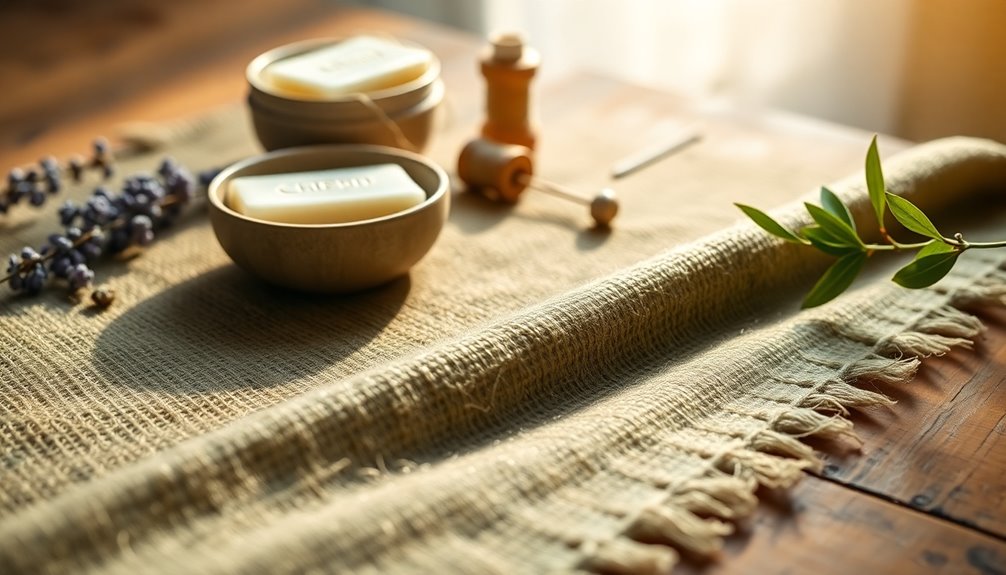
Regular maintenance is essential for keeping your hemp fabric looking its best and extending its lifespan. Start by washing your hemp textiles in cold or lukewarm water to retain their integrity and natural colors. Avoid hot water, as it can weaken the fibers and lead to shrinkage. Hemp fibers are known for their greater resistance to wear and tear, making them an excellent choice for long-lasting garments.
Use mild, eco-friendly detergents, and wash your hemp items separately to prevent pilling from loose fibers. Steer clear of bleach and harsh chemicals that can damage the fabric.
When drying, air-dry your hemp clothing instead of using a dryer. If you must use a tumble dryer, choose a low heat setting and remove them while slightly damp.
Hang your garments in a well-ventilated area, out of direct sunlight, and lay them flat or hang them up to finish drying naturally.
For ironing, tackle wrinkles while the fabric is still damp, or use a steam iron on moderate settings if completely dry. Always iron on the reverse side to preserve the natural color and texture.
Repairing Hemp Fabrics
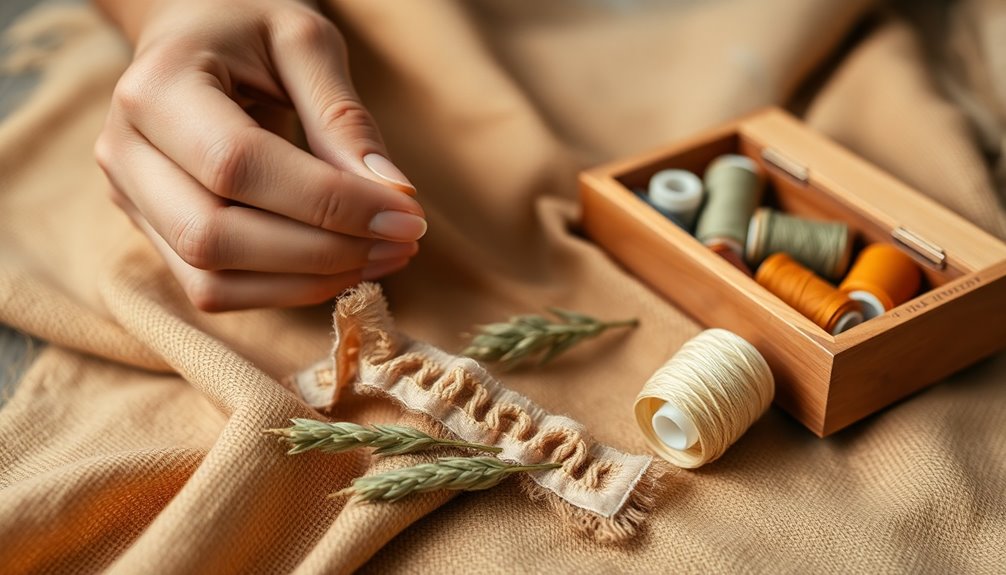
Repairing hemp fabrics requires a thoughtful approach to ensure lasting results. First, assess the damage by evaluating the tear or hole's extent and location. Clean the area around the damage to remove any debris that might complicate the repair. Choose appropriate tools, selecting matching thread and needles compatible with hemp fabric.
If the fabric is threadbare, repairing it can be more challenging, so consider using fusible interfacing. Cut a piece slightly larger than the tear and fuse it with an iron to stabilize the area. For delicate fabrics, a cut-away stabilizer helps prevent fraying. Permanent stabilizers can provide additional support for repairs, especially for lightweight or sheer hemp fabrics.
When sewing, hand-stitching with fine needles creates nearly invisible repairs, while machine sewing with zigzag stitches works well for larger tears. You can also use patching techniques, covering holes with a separate piece of fabric.
For quick fixes, iron-on patches or fabric glue are options, though they mightn't be as durable. Finally, consider visible mending techniques like Sashiko, which not only repairs but adds a decorative touch.
With these methods, you can effectively restore your hemp fabrics and extend their life.
Recycling and Repurposing
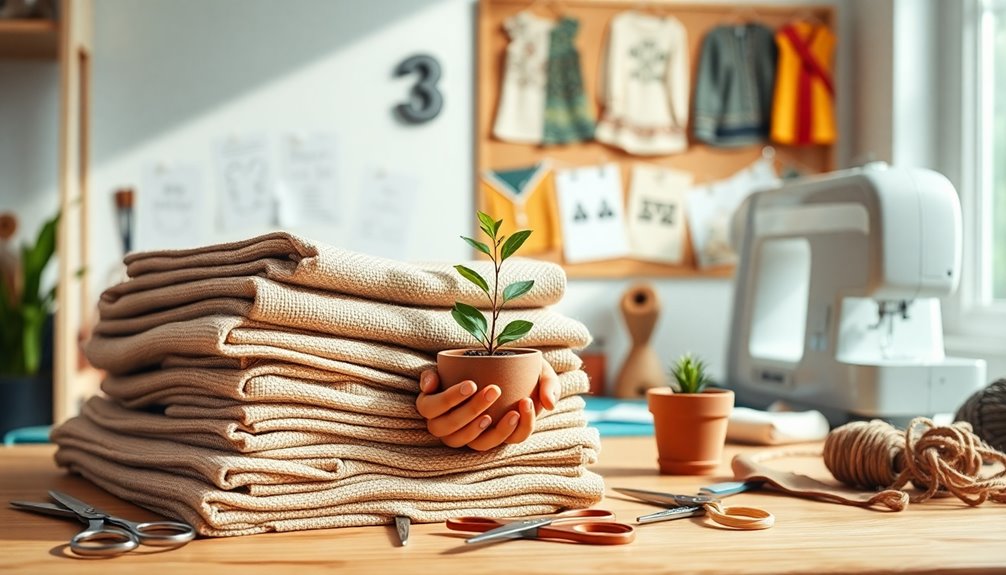
After you've taken care of repairs, it's worth considering how to recycle and repurpose your hemp fabrics to maximize their sustainability.
Hemp fibers can be mechanically separated from the stalk through a process called decortication, which avoids harmful chemicals. This labor-intensive method allows you to create new textiles, ropes, and other products, ensuring minimal waste. While chemical recycling methods exist, they're less common and often less environmentally friendly. Interestingly, Americans generate over 15 million metric tons of textile waste annually, highlighting the importance of recycling efforts like those for hemp. Additionally, the cycle of breakups in consumer habits often leads to increased textile waste, making recycling even more crucial.
You can also repurpose hemp fibers into various items like bandages, bed sheets, or even ceremonial clothing. Traditional uses include ropes and sandals, while modern applications feature hemp paper, which requires less water and can be recycled multiple times. Blending hemp with other materials can enhance its strength and durability, offering eco-friendly alternatives to conventional products.
When your hemp textiles reach the end of their life cycle, remember they're biodegradable and can be composted, reducing greenhouse gas emissions. Additionally, consider recycling or repurposing them to further minimize waste. By managing the end-of-life products effectively, you contribute to a more sustainable future for hemp and the planet.
Sustainability Benefits
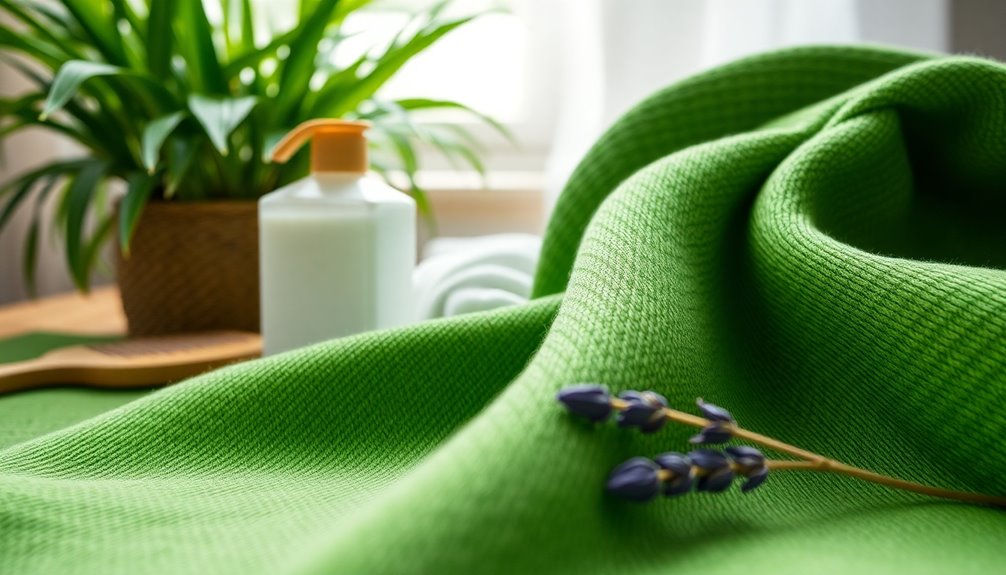
Hemp fabric offers remarkable sustainability benefits that set it apart from conventional textiles. For starters, hemp requires significantly less water than cotton—only about 1/20 of the amount needed. This drought-resistant plant thrives in various climates and improves soil quality, making it a robust alternative in the face of climate change.
Moreover, hemp is a carbon-negative crop, sequestering between 9 to 15 tonnes of CO2 per hectare, which helps mitigate climate change. It also suppresses weeds naturally, reducing the need for harmful pesticides and herbicides. Hemp's usage dates back to ancient civilizations, demonstrating its long-standing significance and utility.
With its fast growth rate, hemp can be harvested within five to eight months, yielding 1200-2000 kilos of fiber per hectare—almost double that of cotton.
In terms of land usage, hemp requires nearly half the space to produce the same fiber amount as cotton, helping maintain soil fertility for subsequent crops. By encouraging biodiversity, especially when grown organically, hemp supports local ecosystems.
All these factors contribute to a lower carbon footprint and improved ecosystem health, making hemp an outstanding choice for sustainable fashion.
Tips for Sustainable Fashion
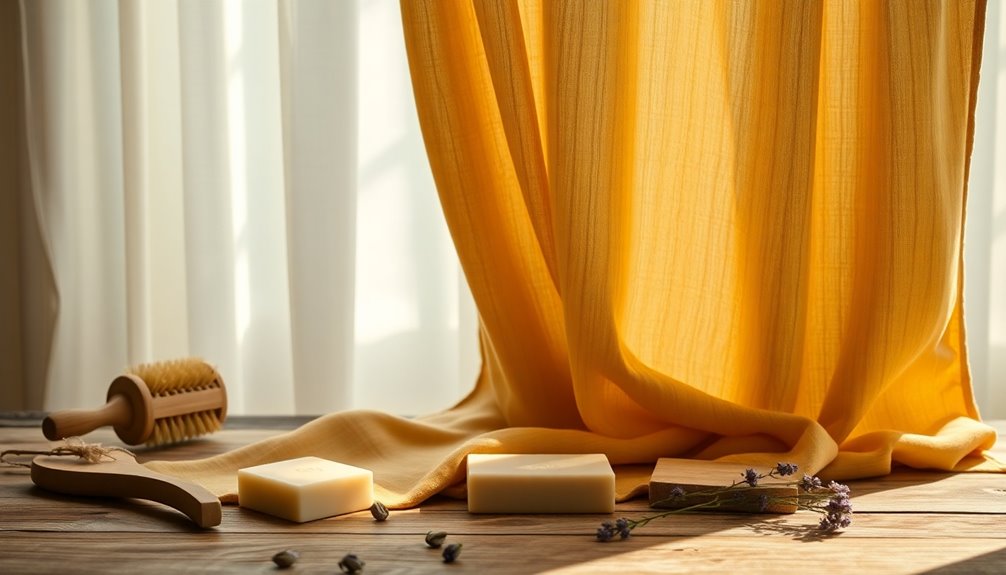
In today’s fast-paced fashion world, making conscious choices is more important than ever. Start by prioritizing quality and timelessness in your wardrobe. Invest in high-quality pieces that last longer, and focus on classic staples like jeans, versatile jackets, and simple tees. Additionally, staying informed about Spanish fashion trends and styles can inspire new ways to incorporate sustainable choices into your wardrobe. Embrace unique designs and patterns that are often featured in Spanish collections, which can elevate your look while remaining environmentally conscious. By blending quality garments with influences from various fashion cultures, you can create a distinctive style that stands the test of time.
Avoid impulse buys; make intentional purchasing decisions and ensure your garments can be worn across multiple seasons. Reduce fast fashion consumption by being mindful of your purchasing habits and choosing sustainable options over low-cost alternatives.
Next, select eco-friendly materials. Opt for organic cotton, which uses less water and fewer chemicals, and consider recycled materials like recycled polyester.
Natural fibers such as linen, hemp, and bamboo are great choices too. Look for certifications like GOTS and GRS to ensure you're making sustainable choices.
Support ethical brands by researching their sourcing, production, and labor practices. Look for brands committed to fair labor practices and check for certifications like Fair Trade and B Corp.
Frequently Asked Questions
Can I Machine Wash Hemp Fabrics With Other Materials?
You shouldn't machine wash hemp fabrics with other materials. It can cause pilling and damage. Instead, wash them separately to preserve their quality and avoid issues like color bleeding and abrasion from different fabrics.
How Do I Prevent Hemp Fabric From Fading Over Time?
To prevent hemp fabric from fading, wash it in cold water, use mild, eco-friendly detergents, and air dry away from direct sunlight. Store it neatly in a cool, dry place to maintain its color.
Are There Specific Detergents Recommended for Hemp Textiles?
Yes, you should use gentle or all-natural detergents for hemp textiles. Avoid harsh chemicals like bleach and fabric softeners. Eco-friendly options help maintain the fabric's quality while keeping it clean and fresh.
How Often Should I Wash My Hemp Garments?
You should wash your hemp garments less frequently due to their antibacterial properties. Typically, you can wear them multiple times unless stained or odorous. Airing them out can also refresh them between washes.
Can Hemp Fabric Be Dyed Without Damaging It?
Yes, you can dye hemp fabric without damaging it. By using compatible dyes and proper preparation techniques, you'll achieve vibrant colors while maintaining the integrity of the fibers. Just follow the right care instructions!
Conclusion
By following these care tips for hemp fabric, you'll not only keep your sustainable fashion pieces looking great, but you'll also extend their lifespan. Remember to wash gently, dry responsibly, and tackle stains promptly. Embracing maintenance and repair can make a big difference in your wardrobe's environmental impact. Plus, recycling or repurposing old hemp textiles contributes to a more sustainable future. With these strategies, you're doing your part for both style and the planet!
